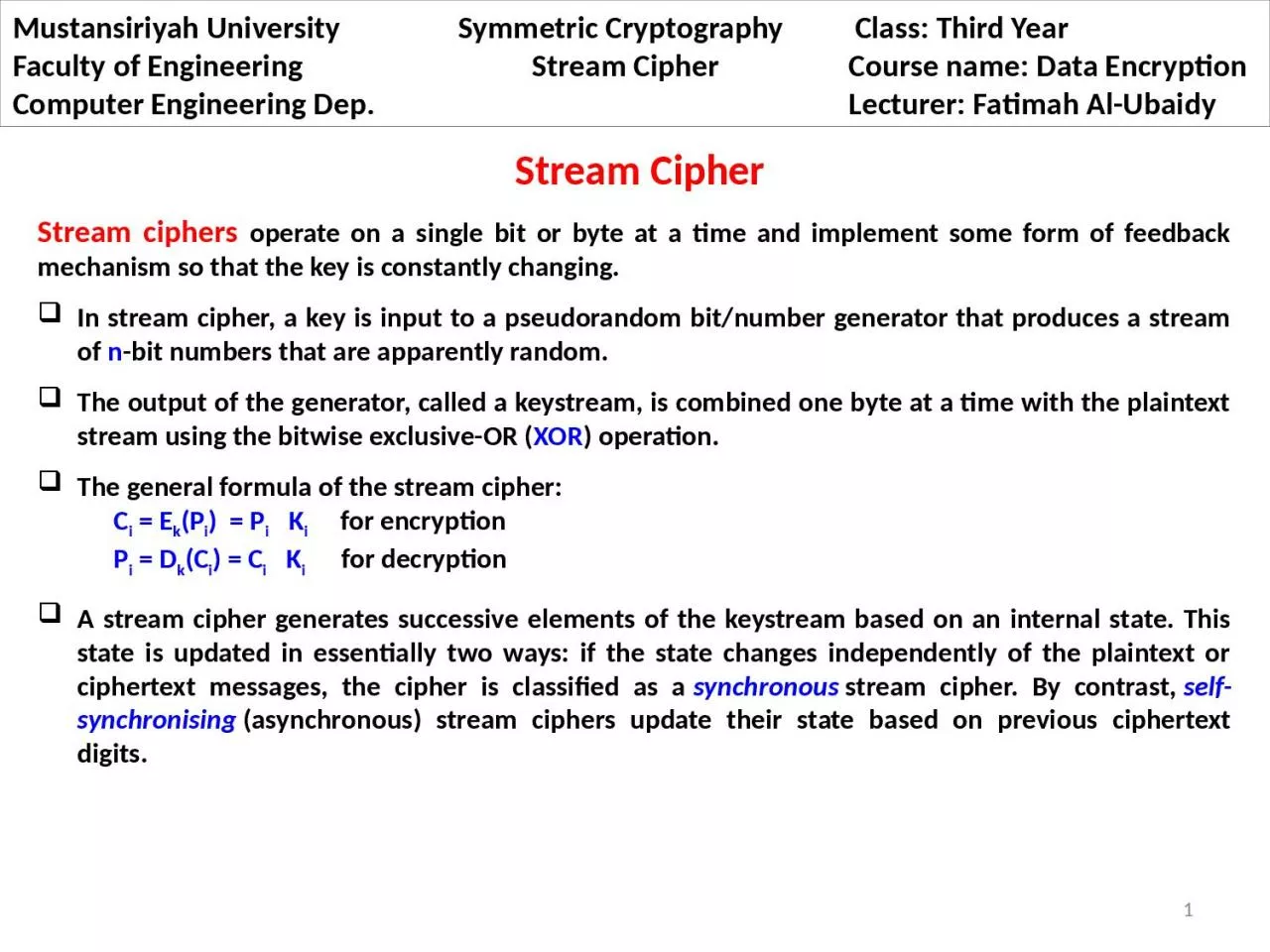/


Faculty of Engineering Stream Cipher Course name Data Encryption Computer Engineering Dep Lecturer Fatimah Al ID: 1018513
Download Presentation The PPT/PDF document "Mustansiriyah University Symme..." is the property of its rightful owner. Permission is granted to download and print the materials on this web site for personal, non-commercial use only, and to display it on your personal computer provided you do not modify the materials and that you retain all copyright notices contained in the materials. By downloading content from our website, you accept the terms of this agreement.
1. Mustansiriyah University Symmetric Cryptography Class: Third YearFaculty of Engineering Stream Cipher Course name: Data EncryptionComputer Engineering Dep. Lecturer: Fatimah Al-Ubaidy1 Stream CipherStream ciphers operate on a single bit or byte at a time and implement some form of feedback mechanism so that the key is constantly changing. In stream cipher, a key is input to a pseudorandom bit/number generator that produces a stream of n-bit numbers that are apparently random.The output of the generator, called a keystream, is combined one byte at a time with the plaintext stream using the bitwise exclusive-OR (XOR) operation.The general formula of the stream cipher: Ci = Ek(Pi) = Pi Ki for encryption Pi = Dk(Ci) = Ci Ki for decryptionA stream cipher generates successive elements of the keystream based on an internal state. This state is updated in essentially two ways: if the state changes independently of the plaintext or ciphertext messages, the cipher is classified as a synchronous stream cipher. By contrast, self-synchronising (asynchronous) stream ciphers update their state based on previous ciphertext digits.
2. Mustansiriyah University Symmetric Cryptography Class: Third YearFaculty of Engineering Stream Cipher Course name: Data EncryptionComputer Engineering Dep. Lecturer: Fatimah Al-Ubaidy2 Stream CipherThe following important design considerations for a stream cipher:(1) The encryption sequence should have a large period. The longer the period of repeat the more difficult it will be to do cryptanalysis. A pseudorandom number generator uses a function that produces a deterministic stream of bits that eventually repeat. The longer the period of repeat, the more difficult it will be to do cryptanalysis.(2) The keystream should approximate the properties of a true random number stream. For example, there should be an approximately equal number of 1s and 0s. (3) the output of the pseudorandom number generator is conditioned on the value of the input key. To guard against brute-force attacks, the key needs to be sufficiently long.Stream Cipher Usage:Stream ciphers are often used for their speed and simplicity of implementation in hardware, and in applications where plaintext comes in quantities of unknowable length like a secure wireless connection. Another advantage of stream ciphers in military cryptography is that the cipher stream can be generated in a separate box that is subject to strict security measures
3. Mustansiriyah University Symmetric Cryptography Class: Third YearFaculty of Engineering Stream Cipher Course name: Data EncryptionComputer Engineering Dep. Lecturer: Fatimah Al-Ubaidy3One Time PadSimilar to stream cipher, one-time pad uses a keystream of completely random digits. This scheme uses a random key that is as long as the message, so that the key need not be repeated. In addition, the key is to be used to encrypt and decrypt a single message, and then is discarded. Each new message requires a new key of the same length as the new message. Such a scheme is unbreakable. It produces random output that bears no statistical relationship to the plaintext.Example: Decrypt the following ciphertext using one-time key and Vigenère scheme with 27 characters in which the twenty-seventh character is the space character,ciphertext: ANKYODKYUREPFJBYOJDSPLREYIUNOFDOIUERFPLUYTSkey: pxlmvmsydofuyrvzwc tnlebnecvgdupahfzzlmnyihplaintext: mr mustard with the candlestick in the hallIn theory, we need look no further for a cipher. The one-time pad offers complete security (perfect secrecy) but, in practice, has two fundamental difficulties:1. There is the practical problem of making large quantities of random keys. 2. There is a problem of key distribution and protection. For every message to be sent, a key of equal length is needed by both sender and receiver.Because of these difficulties, the one-time pad is of limited utility and is useful primarily for low-bandwidth channels requiring very high security.